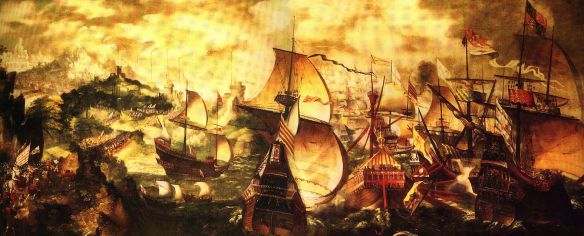Elizabeth I and the Spanish Armada; the Apothecaries painting, sometimes attributed to Nicholas Hilliard. A stylised depiction of key elements of the Armada story: the alarm beacons, Queen Elizabeth at Tilbury, and the sea battle at Gravelines
Sidonia gave no more thought to the invasion. All his thinking was of getting home with as many ships and men as he could. He shepherded survivors back into a ragged defensive crescent and looked to escape. He had few choices: prevailing winds and the English fleet blocked the Armada from the direct route back to Spain. It would have to go the long way around the British Isles, with English guns barking at its heels. The two fleets thus resumed their northward passage and sedate chase. When the Armada was off the shores of Scotland Howard at last turned away, confident Sidonia could not now meet with and escort Parma. It was now that Spanish suffering really began. The fleet spent many days rounding Scotland and the Orkneys, through frigid and unfamiliar seas without even portolan charts for guidance. Then it was south past the west coast of Ireland: more days of struggling through vicious Atlantic storms, shipwrecking on unseen Irish rocks or promontories, tending to 3,000 horribly wounded and burned sailors and marines, sick with hunger or from spoiled fish and bad water, days upon nights of despair and death. On the voyage home though Gaelic waters dark to Spanish ken or experience, the Armada lost fully one-third of its complement: 50 ships and 15,000 men. In all this misery military discipline at last broke down. Sidonia removed and condemned 20 captains and actually hanged one, a neighbor of his from Castile. The corpse dangled from the yardarm of a pinnace which Sidonia paraded through the fleet ‘‘pour encourager les autres.’’
There was no fresh food and the salt fish and pork were rotten in the casks. Far worse, there was almost no unspoiled water. It was only now that the full import of Drake’s raid on Cadiz was understood and felt. To save potable water for the men Sidonia had all horses and mules thrown overboard. The strange sight of thousands of poor beasts swimming in open ocean with no land or ship to be seen was later reported by English and Danish fishing boats. Besides those men dying of battle wounds, burns, and impalements by huge wooden slivers blasted out of the wooden walls of the Spanish ships, hundreds more fell deathly ill daily from disease. When the tattered fleet rounded the bitter coast of Galway it must have seemed that God had abandoned Spain: two weeks of storms ensued and thousands of Spaniards drowned in cold Irish waters as ships wreaked almost daily. Hundreds more had their brains caved in by Irish bounty hunters or English troops as they lay exhausted on rocky beaches. A few made it inland and were given shelter, but most died or were murdered. What is remarkable is that Sidonia got as many ships home as he did: 44 straggled into Spanish harbors, though some of these never sailed again. Nor did the suffering stop even then. For weeks men kept dying, victims of fevers or wounds and of neglect. They died in droves in England, too, from the same causes: medical ignorance and military backwardness that made no provision for plain folk, victor or defeated.
What was won and lost? England remained Protestant and independent. The Eighty Years’ War burned on for another 60 years, leading ultimately to independence also for the Calvinist Netherlands. Yet Spain remained so militarily dominant that it sent two more armadas north against England in the coming decades, and still fought several wars at once against mightier enemies than Elizabeth. But Spain’s reputation for invincibility was lost forever and its confidence was deeply shaken. Imperial Spain was not yet the decrepit and delusional old man it was portrayed to be by one of Philip’s own soldiers, not yet the Don Quixote of Miguel Cervantes’ gentle and affectionate mocking. But it was a wounded and shaken power. The evidence of that change was not long in coming: the very next year Elizabeth sent Drake and a fleet of 126 English warships to Santander, to destroy at anchor what was left of the Spanish Armada.
Suggested Reading: J.F.C. Fuller, A Military History of the Western World, Vol. 2 (1954; 1955); David Howarth, Voyage of the Armada (1981); Colin Martin and Geoffrey Parker, The Spanish Armada (1988); Geoffrey Parker, The Grand Strategy of Philip II (1998).
